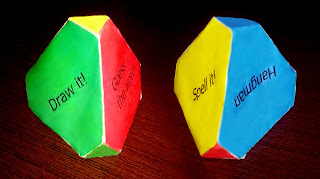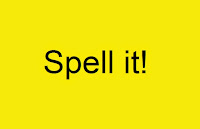As 3rd and 4th
year students are already almost finishing their textbooks, Charo (the English
teacher) asked me to organize some special activities to review the vocabulary
of the topic. So, I started to think about what could I do to make students
have fun and learn at the same time.
I’ve always
believed that games should have more importance in the schools for a very simple
reason: playing is children’s most recurrent and motivating activity at these
ages. So, it’s not comprehensible why teachers avoid it when children start 1st
course of Primary School, that is to say, when they are 6-7 years old. Then, games
and motor activities are replaced completely by textbooks and homework as if one thing was an impediment to achieve the other.
Many studies
have researched about the benefits that playtime in schools can offer to
children’s development. Among these benefits we can highlight the socialization skills, i.e. how to get
along with others, as it offers everyday excellent opportunities to have fun
with other children and to deal with the arguments and difficulties that will
surely appear. It can also encourage the problem-solving,
as during the playtime, children will find many different problems, and plenty
of chances to learn to solve them both alone and with others. Moreover, it can
also help to reach an emotional release,
as moving around is important to burn all the repressed energy accumulated by
kids who must battle to stay calm at a desk during the classroom time. Finally,
the language skills developed when
kids play school games together are also invaluable. Working together as a team
or resolving a conflict during the game, children will develop the language
skills to face many different situations.
Taking into
account all these aspects, I decided to prepare a game in groups, similar to
the Trivial, as I think this game fulfills all the requirements. So, I made
cards of 4 colors (blue, red, yellow and green), each one corresponding to different
challenges which are as follows:
 THE HANGMAN: The blue card corresponds to
the Hangman challenge. This is a very common game among children that can help
them to review the alphabet, and to pay more attention to how certain words or
sentences are written. It also intervenes the guessing factor, as children can
imagine the word or the sentence at issue, stimulating certain mental processes,
that are not through other kind of activities.
THE HANGMAN: The blue card corresponds to
the Hangman challenge. This is a very common game among children that can help
them to review the alphabet, and to pay more attention to how certain words or
sentences are written. It also intervenes the guessing factor, as children can
imagine the word or the sentence at issue, stimulating certain mental processes,
that are not through other kind of activities.
GUESS THE WORD: This challenge consists of guessing the word or the sentence that is written on the card, by the mimics or
the clues given by one of the members of the group. For example, in 3rd
grade they had to guess the name of an animal by saying physical characteristics
or the things that they can or can’t do. On the other hand, 4th
grade students had to guess which action of the day their classmate was referring
to by miming. The evaluation of this challenge is quite positive because students
definitely loved it.
SPELL IT! From my point of view, this is the most simple and
useless challenge of all, because it only consists in spelling a word. So, although
it can help to review the English alphabet (since most of 3rd and 4th
grade students haven’t learned it yet), and to pay more attention to the
correct way of writing these words, students were not very motivated doing this
challenge and it is far from my objective of communicative learning.
 DRAW IT! Finally, this challenge consists in guessing a word
by the drawing of one of the members of the group in the blackboard. Students liked this challenge and they were
very motivated by doing it. Furthermore, we can encourage students’
communication in the foreign language by proposing them to ask questions like: is
it a monkey?
DRAW IT! Finally, this challenge consists in guessing a word
by the drawing of one of the members of the group in the blackboard. Students liked this challenge and they were
very motivated by doing it. Furthermore, we can encourage students’
communication in the foreign language by proposing them to ask questions like: is
it a monkey?  |
| 4 sided dice |
To carry out
this game, first of all we divided the classroom into four groups considering they
were compensated. After that, one member of the first group had to roll a 4
sided dice, and to do one of the challenges explained previously, according to
the color of the dice. If the answer was correct, they won a point, and the
first having two points of each challenge was the winner.
As a general
review of this game, I can say that it can be very useful, but we need to know
very well how to handle it to take advantage of all its possibilities. We have to
establish from the very beginning what our objectives are, and how we pretend to
accomplish them. In my case, I’ve not checked properly students’ previous and
final knowledge in order to see to what extent this activity has been useful. Nevertheless,
I’m happy about how I’ve managed the group problems that have emerged, since I’ve
checked how has improved students’ way to organize the groups and to respect the
time of participation of each student.
 |
| Final result in 3rd grade class |





No comments:
Post a Comment